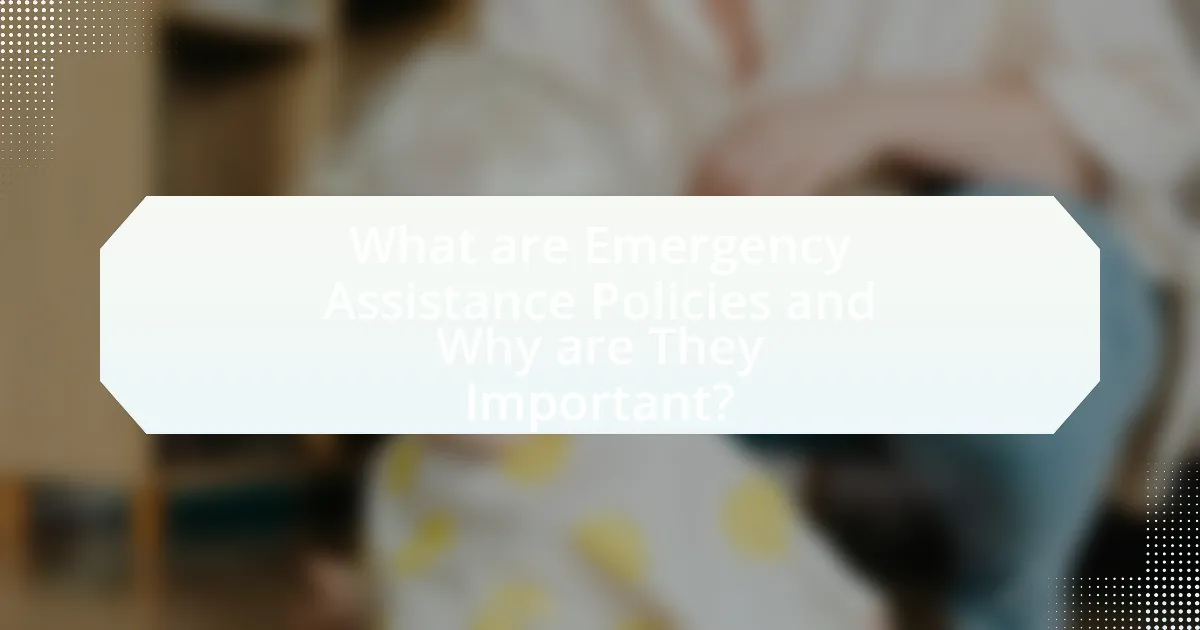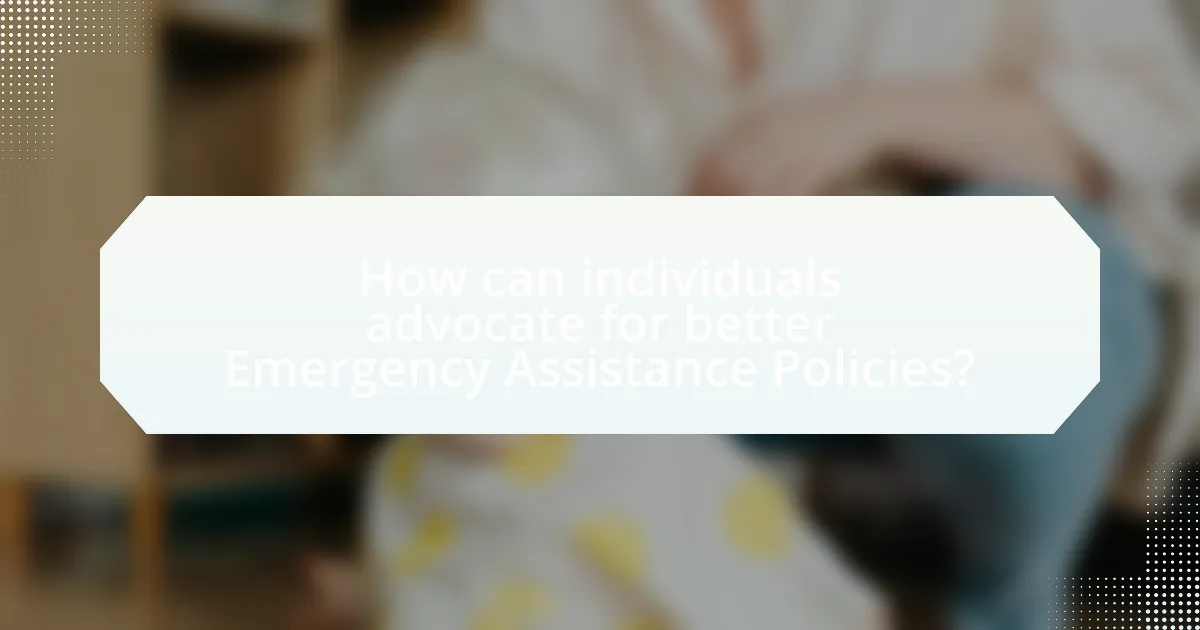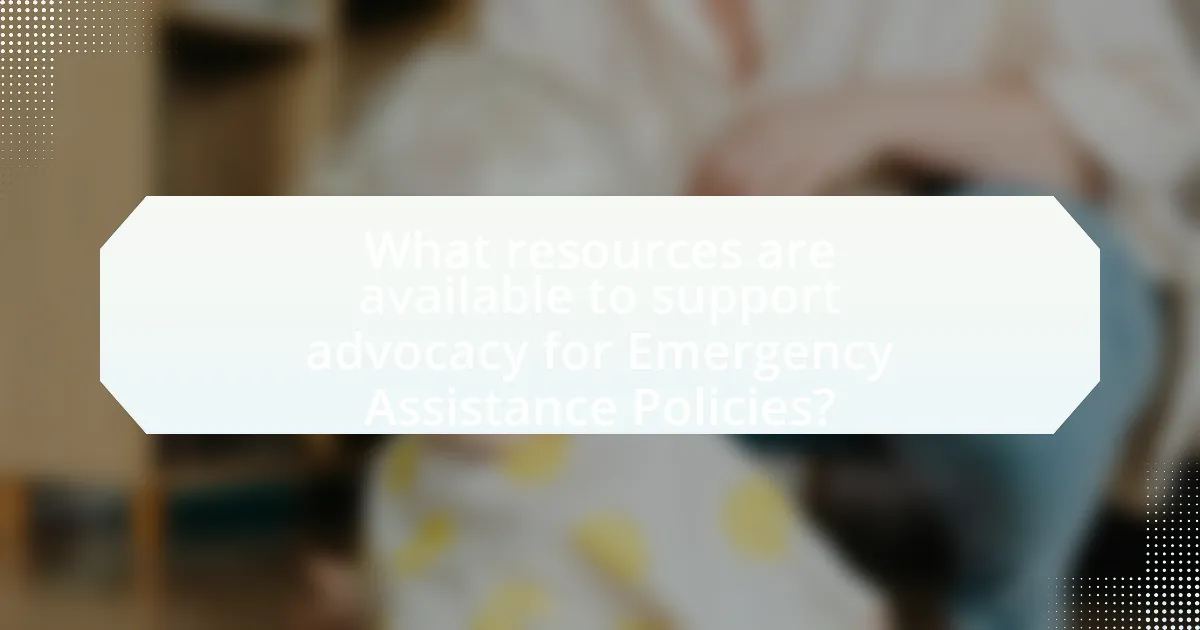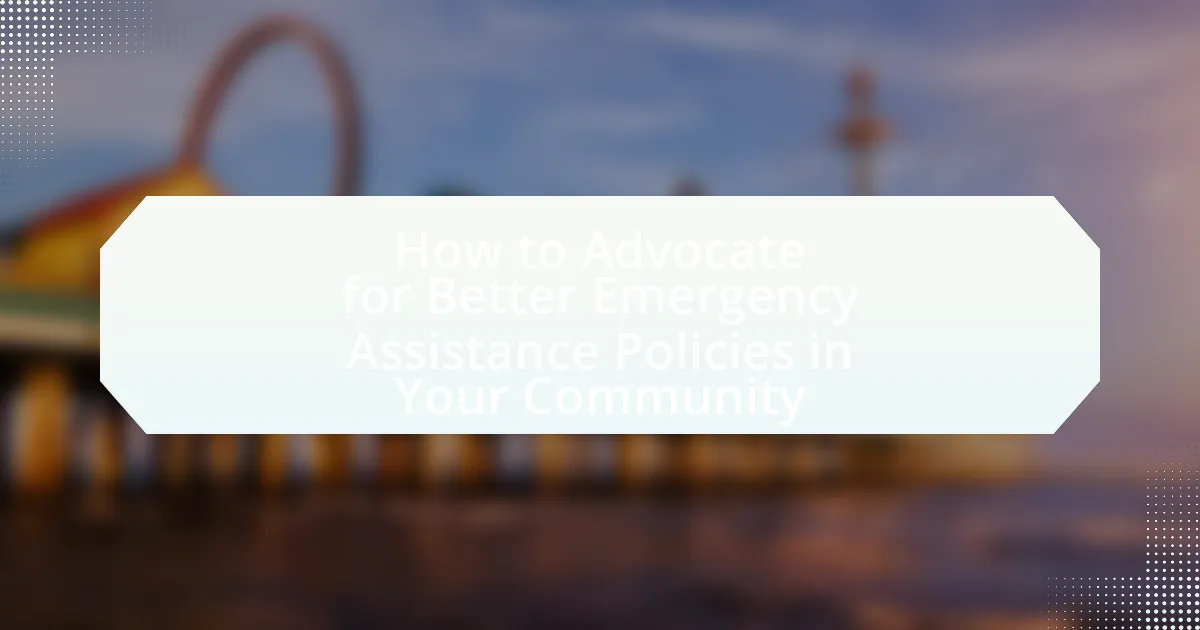Emergency Assistance Policies are essential frameworks established by governments and organizations to provide immediate support to individuals and families during crises, such as natural disasters or health emergencies. This article outlines the importance of these policies, their impact on communities, and the key components that make them effective. It also addresses the challenges faced in implementing these policies, particularly for vulnerable populations, and offers strategies for individuals to advocate for improvements. Additionally, the article highlights the role of community engagement, data-driven advocacy, and collaboration among local groups to enhance emergency assistance initiatives.

What are Emergency Assistance Policies and Why are They Important?
Emergency Assistance Policies are frameworks established by governments or organizations to provide immediate support to individuals and families facing crises, such as natural disasters, economic hardship, or health emergencies. These policies are crucial because they ensure timely access to essential resources like food, shelter, and medical care, which can significantly mitigate the impact of emergencies on vulnerable populations. For instance, during the COVID-19 pandemic, emergency assistance policies in various countries included direct financial aid and expanded unemployment benefits, which helped millions maintain basic living standards.
How do Emergency Assistance Policies impact communities?
Emergency Assistance Policies significantly impact communities by providing essential support during crises, which helps stabilize local economies and enhance social cohesion. These policies ensure that vulnerable populations receive timely aid, such as food, shelter, and healthcare, which can reduce the long-term effects of disasters. For instance, research from the Federal Emergency Management Agency (FEMA) indicates that communities with robust emergency assistance frameworks recover more quickly from natural disasters, as they can mobilize resources effectively and maintain public trust. This support not only addresses immediate needs but also fosters resilience, enabling communities to better prepare for future emergencies.
What are the key components of effective Emergency Assistance Policies?
Effective Emergency Assistance Policies consist of clear eligibility criteria, timely response mechanisms, comprehensive resource allocation, and robust communication strategies. Clear eligibility criteria ensure that assistance reaches those most in need, while timely response mechanisms facilitate rapid deployment of aid during crises. Comprehensive resource allocation guarantees that sufficient funds and materials are available to meet demand, and robust communication strategies keep affected communities informed about available assistance and procedures. These components are essential for ensuring that emergency assistance is effective and responsive to community needs.
How do these policies address the needs of vulnerable populations?
These policies address the needs of vulnerable populations by providing targeted support and resources tailored to their specific challenges. For instance, emergency assistance policies often include provisions for food security, housing stability, and healthcare access, which are critical for low-income families and individuals facing crises. Research indicates that during disasters, marginalized groups experience higher rates of negative outcomes; thus, policies that prioritize these populations can mitigate such impacts. For example, the Federal Emergency Management Agency (FEMA) has implemented programs that specifically assist low-income households, ensuring they receive timely aid and resources during emergencies.
What challenges do communities face regarding Emergency Assistance Policies?
Communities face several challenges regarding Emergency Assistance Policies, including inadequate funding, lack of awareness, and bureaucratic barriers. Inadequate funding often leads to insufficient resources to meet the needs of vulnerable populations during crises, as evidenced by reports indicating that many emergency programs operate on limited budgets that do not cover all necessary services. Lack of awareness among community members about available assistance can result in underutilization of resources, with studies showing that many eligible individuals do not seek help due to misinformation or lack of outreach. Bureaucratic barriers, such as complex application processes and stringent eligibility criteria, further complicate access to assistance, as highlighted by research from the Urban Institute, which found that these obstacles disproportionately affect marginalized groups.
What are common gaps in current Emergency Assistance Policies?
Common gaps in current Emergency Assistance Policies include inadequate funding, lack of accessibility, and insufficient coordination among agencies. Inadequate funding often leads to limited resources for those in need, as seen in the aftermath of natural disasters where assistance falls short of demand. Lack of accessibility can prevent vulnerable populations, such as the elderly or disabled, from receiving timely help, highlighting the need for policies that consider diverse community needs. Insufficient coordination among agencies results in fragmented services, causing delays and confusion for individuals seeking assistance, as evidenced by reports from organizations like the National Emergency Management Agency. These gaps hinder effective emergency response and recovery efforts.
How do socio-economic factors influence the effectiveness of these policies?
Socio-economic factors significantly influence the effectiveness of emergency assistance policies by determining access to resources and the overall impact on vulnerable populations. For instance, individuals from lower socio-economic backgrounds often face barriers such as limited access to information, transportation, and financial resources, which can hinder their ability to utilize available assistance. Research indicates that communities with higher poverty rates experience lower participation in emergency programs, as seen in a study by the Urban Institute, which found that only 30% of eligible low-income families accessed emergency aid compared to 70% of higher-income families. This disparity highlights how socio-economic status directly affects policy effectiveness, as those in need may not benefit fully from the intended support due to systemic obstacles.

How can individuals advocate for better Emergency Assistance Policies?
Individuals can advocate for better Emergency Assistance Policies by engaging in community organizing, participating in local government meetings, and collaborating with advocacy groups. Community organizing allows individuals to mobilize support and raise awareness about the need for improved policies. Participation in local government meetings provides a platform to voice concerns and propose changes directly to decision-makers. Collaborating with advocacy groups can amplify efforts, as these organizations often have established networks and resources to influence policy effectively. For example, the National Emergency Management Agency emphasizes the importance of community involvement in shaping effective emergency response strategies, highlighting that grassroots advocacy can lead to significant policy improvements.
What steps can community members take to initiate advocacy?
Community members can initiate advocacy by organizing a coalition to identify specific issues related to emergency assistance policies. This coalition should gather data on the current policies, engage with affected individuals to understand their experiences, and develop a clear set of goals for change. Research indicates that grassroots movements, such as those documented in the “Community Organizing and Social Change” study by the University of Southern California, show that collective action can effectively influence policy decisions. By presenting well-researched proposals to local government officials and participating in public forums, community members can amplify their voices and push for necessary reforms in emergency assistance policies.
How can individuals identify key stakeholders in their community?
Individuals can identify key stakeholders in their community by mapping out influential groups and individuals who have a vested interest in local issues. This process involves researching community organizations, local government officials, business leaders, and advocacy groups that are involved in emergency assistance policies. Engaging in community meetings, utilizing social media platforms, and reviewing local news sources can provide insights into who is actively participating in discussions and decision-making processes. Additionally, tools like stakeholder analysis frameworks can help categorize these stakeholders based on their influence and interest in emergency assistance, ensuring a comprehensive understanding of the community landscape.
What role does community engagement play in advocacy efforts?
Community engagement is crucial in advocacy efforts as it fosters collaboration, builds trust, and amplifies the voices of those affected by issues. Engaging the community allows advocates to gather diverse perspectives, ensuring that the advocacy efforts are representative and address the actual needs of the population. Research indicates that initiatives with strong community involvement are more likely to succeed; for instance, a study by the National Civic League found that communities with active engagement saw a 30% increase in successful policy changes. This demonstrates that community engagement not only enhances the effectiveness of advocacy but also leads to more sustainable and impactful outcomes.
What strategies are effective in advocating for policy change?
Effective strategies for advocating for policy change include building coalitions, utilizing data-driven arguments, and engaging in grassroots mobilization. Building coalitions with diverse stakeholders enhances credibility and broadens support, as seen in successful campaigns like the Affordable Care Act, which involved various health organizations. Utilizing data-driven arguments, such as presenting statistics on the impact of emergency assistance policies, can persuade policymakers by demonstrating the need for change; for example, research shows that communities with robust emergency assistance programs experience lower rates of homelessness. Grassroots mobilization, through community organizing and public demonstrations, empowers citizens to voice their concerns, as evidenced by movements like Black Lives Matter, which have effectively influenced policy discussions.
How can data and personal stories be used to strengthen advocacy efforts?
Data and personal stories can strengthen advocacy efforts by providing compelling evidence and emotional resonance that engage stakeholders. Data offers quantifiable insights, such as statistics on the number of individuals affected by inadequate emergency assistance, which can highlight the urgency of the issue. For instance, a report from the Federal Emergency Management Agency indicates that 40% of households affected by disasters do not receive adequate assistance. Personal stories humanize these statistics, illustrating the real-life impact of policies on individuals and communities. By combining data with narratives, advocates can create a powerful message that appeals to both logic and emotion, thereby increasing the likelihood of policy change.
What are the best practices for communicating with policymakers?
The best practices for communicating with policymakers include being clear, concise, and focused on key messages. Effective communication should prioritize the use of data and evidence to support arguments, as policymakers often rely on factual information to make decisions. Engaging in active listening is crucial, as it allows advocates to understand policymakers’ perspectives and concerns. Building relationships through regular interactions and follow-ups enhances trust and credibility. Tailoring messages to align with policymakers’ priorities and interests increases the likelihood of engagement. Additionally, utilizing multiple communication channels, such as emails, meetings, and social media, ensures broader reach and impact.

What resources are available to support advocacy for Emergency Assistance Policies?
Resources available to support advocacy for Emergency Assistance Policies include nonprofit organizations, government agencies, and community coalitions. Nonprofit organizations such as the National Low Income Housing Coalition provide research, policy analysis, and advocacy tools specifically aimed at improving emergency assistance programs. Government agencies like the U.S. Department of Health and Human Services offer guidelines and funding opportunities for emergency assistance initiatives. Additionally, community coalitions often create local advocacy networks that mobilize residents and stakeholders to influence policy changes effectively. These resources collectively empower advocates with the necessary information, support, and strategies to promote better emergency assistance policies in their communities.
What organizations focus on improving Emergency Assistance Policies?
Organizations that focus on improving Emergency Assistance Policies include the American Red Cross, the National Emergency Management Agency, and the Federal Emergency Management Agency (FEMA). The American Red Cross provides disaster relief and advocates for policies that enhance emergency preparedness and response. The National Emergency Management Agency works to improve national emergency management policies and practices. FEMA, as a federal agency, develops and implements policies to support disaster response and recovery efforts across the United States. These organizations play critical roles in shaping effective emergency assistance frameworks and policies.
How can local groups collaborate to enhance advocacy efforts?
Local groups can collaborate to enhance advocacy efforts by forming coalitions that unify their resources and expertise. This collaboration allows for a stronger collective voice, which can influence policy changes more effectively than individual efforts. For instance, when multiple organizations focus on emergency assistance policies, they can share data, coordinate outreach campaigns, and pool funding for joint initiatives. Research shows that coalitions can increase advocacy effectiveness by up to 50%, as demonstrated in studies conducted by the National Council of Nonprofits, which highlight the benefits of collaborative advocacy in achieving common goals.
What funding opportunities exist for advocacy initiatives?
Funding opportunities for advocacy initiatives include grants from foundations, government funding, and crowdfunding platforms. Foundations such as the Ford Foundation and the Open Society Foundations provide financial support specifically for advocacy work aimed at social change. Government agencies often allocate funds for community-based initiatives, particularly through programs like the Community Development Block Grant. Additionally, crowdfunding platforms like GoFundMe and Kickstarter allow individuals and organizations to raise money directly from the public for specific advocacy projects. These funding sources are essential for sustaining advocacy efforts and implementing effective community programs.
What tools can individuals use to measure the impact of their advocacy?
Individuals can use various tools to measure the impact of their advocacy, including surveys, social media analytics, and impact assessment frameworks. Surveys can gather quantitative and qualitative data from community members regarding their perceptions and experiences related to advocacy efforts. Social media analytics tools, such as Hootsuite or Google Analytics, can track engagement metrics, reach, and audience sentiment, providing insights into the effectiveness of messaging. Impact assessment frameworks, like the Logic Model or Theory of Change, help individuals systematically evaluate the outcomes of their advocacy initiatives by linking activities to desired changes. These tools collectively enable individuals to assess the effectiveness and reach of their advocacy efforts in promoting better emergency assistance policies.
How can community feedback be collected and utilized effectively?
Community feedback can be collected and utilized effectively through structured surveys, focus groups, and public forums. These methods allow for the gathering of diverse perspectives and insights from community members regarding emergency assistance policies. For instance, surveys can quantify opinions and identify common concerns, while focus groups facilitate in-depth discussions that reveal underlying issues. Public forums encourage open dialogue, fostering a sense of community involvement and ownership in the policy-making process. Research indicates that communities that actively engage residents in feedback mechanisms see a 30% increase in policy acceptance and effectiveness, as reported by the National Civic League. This demonstrates that effective collection and utilization of community feedback not only enhances policy relevance but also strengthens community trust and collaboration.
What metrics should be tracked to assess policy changes?
To assess policy changes, key metrics include the number of individuals served, the effectiveness of service delivery, and the impact on community well-being. Tracking the number of individuals served provides insight into the reach of the policy, while evaluating service delivery effectiveness can reveal operational strengths and weaknesses. Additionally, measuring community well-being through indicators such as economic stability, health outcomes, and social cohesion can demonstrate the broader effects of the policy changes. These metrics are essential for understanding the real-world implications of policy adjustments and ensuring accountability in emergency assistance programs.
What are some practical tips for successful advocacy in your community?
To successfully advocate in your community, engage with local stakeholders, build coalitions, and communicate effectively. Engaging with local stakeholders, such as community leaders and organizations, fosters collaboration and support for your cause. Building coalitions with like-minded groups amplifies your voice and resources, increasing the impact of your advocacy efforts. Effective communication, including clear messaging and active listening, ensures that your message resonates with the community and decision-makers. Research shows that advocacy efforts are more successful when they involve diverse community participation and clear, actionable goals, as highlighted in the “Community Advocacy Toolkit” by the National Association of Social Workers.

Leave a Reply